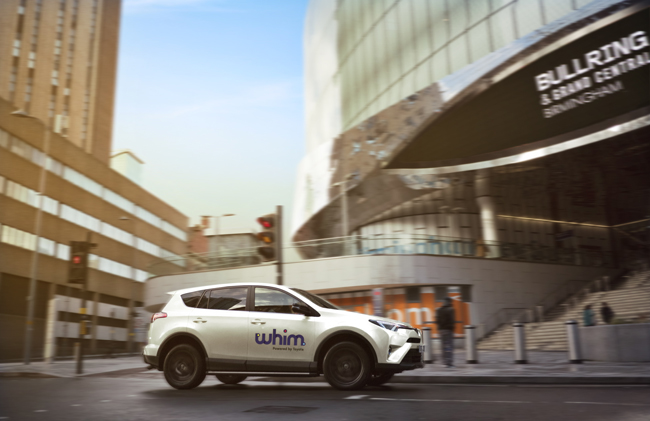
Mobility as a Service (MaaS) platforms will replace 2.3 billion urban private car journeys by 2023, according to a new study. This is equivalent to 18 times the number of taxi journeys across New York in 2016.
The findings by Juniper Research show that western Europe will lead the way by accounting for 83% of global MaaS trips.
The report, Mobility as a Service: Emerging Opportunities, Vendor Strategies & Market Forecasts 2018-2023, says Finnish capital Helsinki will lead MaaS implementation, followed by Stockholm, Sweden and Vienna, Austria.
Helsinki is where MaaS Global’s Whim app is in operation. Research author Nick Maynard says the city’s winning position is a result of collabora-tion between the country’s government and MaaS vendors.
“Stakeholder partnerships are fundamental to MaaS in order to develop a viable multimodal system delivering significant cost and time savings to the user,” Maynard explains.
Juniper defines MaaS as urban transport solutions that are integrated into a single platform by which users can determine the best route and price across several end-to-end travel services and modes, according to real-time data such as traffic conditions and demand. For users, MaaS will be offered in the form of an app which is accessible at any time across many connected devices.
MaaS traction
With this in mind, the success of public-private partnerships, the high quality of transport service provision and positive trial outcomes are major factors for MaaS traction in Europe, according to the report.
MaaS introduction is also expected to lead to annual time savings of over 500 million hours by 2023. The on-demand service enabled by MaaS will lead to more efficient use of road vehicles, reducing peak traffic levels and lowering both congestion and air pollution, Juniper adds.
However, in the US MaaS is predicted to grow more slowly due to what Juniper describes as a fragmented state and federal system, combined with ‘lukewarm’ legislative support for regulation. In addition, a current lack of federal concern over environmental issues also means that one major driver for the deployment of MaaS is not present in the US. Dr Kari Watkins from Georgia Institute of Technology (Georgia Tech) says MaaS requires an exten-sive underlying public transportation network to be successful – but the US has very few cities where the transit network is extensive enough to serve as a backbone.
“By prioritising automobile traffic, we make people seeking multimodal transportation options second-class citizens,” Watkins adds. “Cities where MaaS will be successful must first give priority to collective modes such as public transit and then use the other components of MaaS to supplement and support that backbone.”
Watkins explains that Stockholm and Vienna have both the transit networks and the appropriate legislative support to achieve this.
Slower growth
Adela Spulber, transportation systems analyst at the Center for Automotive Research, also believes MaaS will grow more slowly in the US because public transit networks are less developed than those in Europe. But she disagrees that the problem lies in a fragmented state and federal system per se.
“The problem is the lack of political will at the federal and state level, and at the local level in many areas, to fund public transit,” she insists.
According to Spulber, this is a bigger obstacle to MaaS than legislation relating to mobile ticketing, taxation, revenue sharing and data sharing.
Stockholm and Vienna are early adopters, she continues. “But I think that in the next five years other cities with large transit networks and many shared mobility options will have MaaS platforms too, such as Paris, London, Munich.”
According to Spulber, MaaS implementation could be accelerated through more investment in public transit, data-sharing formats, strong local government leadership in favour of MaaS, modernisation of transit agency purchasing and contracting models, higher fuel prices, less generous parking policies - and a better bike infrastructure.
Sumithra Jagannath, president of Zed Digital, insists a significant regulatory reform is needed to unify policy to accomplish MaaS: “This is extremely difficult to accomplish on a state/regional level in the US - and is even more difficult on a national level. Europe may be better positioned here in the short term.”
Jagannath emphasises that MaaS requires good public-private partnerships and says there is currently an unwillingness on the part of private transportation and ride-share providers to share data with public sector agencies.
Potential barriers
There are other potential barriers around vulnerable and poorer users: for instance, part of the Americans with Disabilities Act requires vehicles to be accessible for people with special needs and wheelchairs – something that is not always supported by all private transportation and ride-share providers.
Also, under Title 6 of the Civil Rights Act of 1964, transit agencies would need to ensure MaaS solutions are available for citizens who don’t have bank accounts or who prefer cash transactions. Title 6 was established to protect people against discrimination on grounds of race, colour and national origin in programmes and activities which receive federal financial assistance.
MaaS solutions also must provide solutions for those without smartphones, as current software is primarily smartphone-based, Jagannath adds.
Adrian Schönig, chief technology officer at Skedgo, expects companies like Uber and Lyft to lead MaaS in the US: “Lyft is experimenting with free monthly packages to give up their cars and both are working with public transport authorities and extending and investing into bike- and scooter-sharing.”
Schönig believes scooter-share offers a first mile/last mile solution to provide feeder services into mass transit, which serves as a suitable step towards establishing MaaS. He thinks there is more of a push in Europe towards MaaS by public transport authorities (PTAs) - especially in cities which actively work with them: “They want to get people to rely less on cars as European inner cities were mostly developed before the rise of cars [in contrast to the US] and are more suitable to alternative modes.”
Sandra Witzel, Skedgo’s head of marketing, thinks growth in MaaS will come from city governments feeling pressure from large multinationals which require the quick movement of people and goods. “Amazon’s search for their second HQ has raised awareness on how important access to mass transit is for employers these days and it will push cities to move faster, despite lack of federal support,” Witzel adds.
Aggressive expansion
She explains new mobility companies such as ride-share and micro-mobility providers will push the trend further with “aggressive” expansion drives: “As the example of Uber shows, they are not waiting for legislation to happen but rather act first and deal with the consequences later.”
The lack of broad and modern public transit will slow down the trend towards MaaS in the US – at least when compared to Europe, where it is easi-er to integrate new first mile/last mile solutions into well-functioning mass transport networks, Witzel concludes.
Andy Boenau, director of outreach & engagement at Gotcha, insists MaaS will play a huge role in reducing single-occupant vehicles as half of Ameri-ca’s trips are three miles or less – and it costs up to $10,000 each year to own a minivan or SUV.
“The tipping point for behaviour change will come when customers have convenient transportation options at a fair monthly price,” Boenau adds.
He suggests that the rise of movie-streaming provider Netflix shows that people can choose to subscribe to services rather than purchasing. “Gotcha is already doing this with scooters, bicycles, and low-speed electric vehicles,” he concludes. “Our library of shared mobility devices will only grow.”
Admittedly, a lot of work is required to accelerate MaaS deployment in the US, perhaps through greater levels of investment to improve the country’s transportation network as well as a wider range of transport options to sway the public away from car ownership (see box). Therefore the MaaS split between Europe and the US seems likely to continue – yet it is not inevitable.
Auto suggestion
In a separate white paper, Juniper Research reveals a strong reliance on car ownership in the US. This is based on 2017 figures which show consumer vehicles in service had reached a 64.1% penetration within the population – the highest in any country in the world. The paper, Why Mobility-as-a-Service is the Future of City Transport, says MaaS presents a technological and social challenge to convince users it is a suitable replacement for private car usage, as opposed to public transit alone.
A reduction in the demand for new vehicles could heighten a need for car manufacturers switching ownership models or investing in new concepts and technology – both of which require significant investment, the paper adds.
Some manufacturers such as BMW, Daimler, Volkswagen, General Motors and Toyota are working to promote their own efforts in the MaaS space. Juniper believes this presents an opportunity for manufacturers to influence the role they will have in the future of mobility.
Also, governments will need to invest heavily in electric vehicle charging point provision and smart grid technologies to manage power re-quirements.
MaaS experience
Additional funding will also be required to meet the increase in public transport services brought about by MaaS, the paper emphasises.
Juniper insists the ticketing and subscription models adopted by different vendors are crucial to the success of MaaS. The document sug-gests journey planners need to work with ticketing vendors to ensure a comprehensive MaaS experience for all users.
The potential of MaaS is pegged on the ability of open data to allow multiple providers to use actual transit data to establish what ser-vices are required where - and at what price. Also, open data initiatives must be supported by national and local governments to establish data sharing as a precursor to MaaS pilots.
Juniper believes ride-sharing services are actually ‘ride-sourcing’ solutions and their potential for removing cars from the road via shared trips is limited as they drop users off at the roadside at random spots – causing extra congestion on city streets.
By integrating ride-share solutions in the broader MaaS ecosystem, MaaS apps can provide a way to transition ‘ride-sourcing’ vendors into ride-sharing vendors seamlessly.












